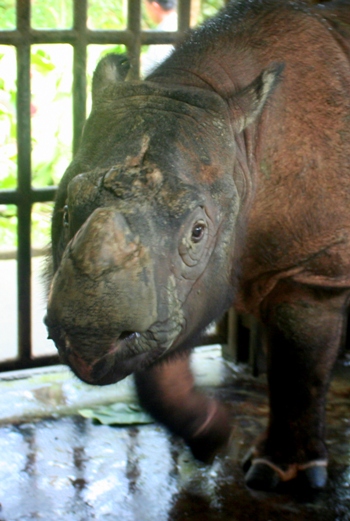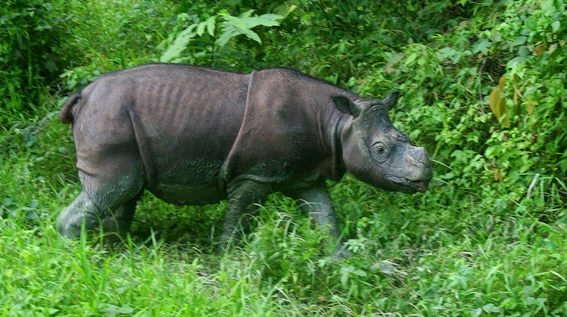With less than 40 individuals left in the world, the Bornean rhino is a small step away from extinction. Yet conservationists and government officials in the Malaysian state of Sabah are not letting this subspecies of the Sumatran rhino go without a fight. Implementing a daring last-ditch plan to save the animal, officials are working to capture a wild female to mate with a fertile male named Tam, who was rescued after wandering injured into a palm oil plantation two years ago.
“Tam has been in a forest paddock since August 2008, was shown to have viable sperm in November 2009, and may die of old age without reproducing if he is not found a mate soon,” Junaidi Payne of the Borneo Rhino Alliance (BORA) explained to mongabay.com when asked why a wild female must be caught for breeding.
“Although there are some people who feel otherwise, the fact is that the Bornean rhino is almost certain to drift to extinction without active human intervention to boost birth rate of the species. There are hardly any breeding female rhinos left in the wild. It is my belief that, even with constant protection, if rhinos are just left in the wild, the numbers and distribution of breeding individuals, along with the likelihood of inbreeding, may mean that the species will disappear.”
 Male Bornean rhino, Tam. Photo by: Jeremy Hance. |
The female was spotted on a camera trap and has been monitored in her habitat since 2007. The decision has now been made to capture her: officials have created a pitfall trap by digging a large hole, placing a crate inside, and covering it with a trap door. The trap is monitored twice a day. Now all conservationists must do is wait.
Payne says that he believes the female has become totally isolated from other rhinos, a fate not uncommon in Sabah where large-scale logging followed by extensive palm oil plantations have whittled many rainforest areas into smaller and smaller pockets. For Bornean rhinos—shy, deep forest dwellers—palm oil plantations present an impenetrable barrier.
“There is no evidence that any other rhino has entered [the female rhino’s] roughly 1,500 hectare home range since 2007,” Payne says. “We cannot discount the possibility of that but then, why has she not become pregnant and produced a baby?”
Tam, the male rhino, now lives in his own 2.5 hectare pen in an undisclosed location; he is guarded day and night by an anti-poaching squad. To facilitate the captured rhinos breeding, officials plan build a vast fenced in sanctuary, spreading over 4,500 hectares. In such a sanctuary the rhinos could be closely monitored—and protected from poachers—but left largely alone to breed. Payne argues that this is the best way forward, considering that close captivity of Sumatran rhinos in the past produced little success.
However, Payne says the plan for the sanctuary is moving too slowly for a species facing imminent extinction.
“As one gets older, time seems to go quickly. Even allowing for that, I am quite frustrated with the slow speed of progress in construction of the long term Borneo Rhino Sanctuary. This infrastructure is financed under the government’s Sabah Development Corridor program”
Bornean rhinos (Dicerorhinus sumatrensis harrissoni) are a subspecies of the Sumatran rhino, which is listed as Critically Endangered by the IUCN Red List. Surviving in Peninsular Malaysia, Borneo, and Sumatra, the species has an estimated 250 individuals left. The rhinos have been decimated by large-scale habitat loss combined with poaching. Rhinos worldwide are threatened by poaching for their horns, which are used in traditional Chinese medicines. Demand for the illegal trade remains high, although scientists have found no curative properties in the horn. There are currently efforts in Sumatra to breed the Sumatran rhino, but they so far have proven unsuccessful.
The Sumatran rhino (Dicerorhinus sumatrensis) is the world’s smallest rhinoceros. Covered with black hair, the species is thought to be the most ancient rhino alive, closely related in fact to the extinct woolly rhinoceros.

The best chance to save the Bornean rhino? Fertile male, Tam, wanders in his 2.5 hectare enclosure. Photo by: Jeremy Hance
Related articles
Face-to-face with what may be the last of the world’s smallest rhino, the Bornean rhinoceros

(12/01/2009) Nothing can really prepare a person for coming face-to-face with what may be the last of a species. I had known for a week that I would be fortunate enough to meet Tam. I’d heard stories of his gentle demeanor, discussed his current situation with experts, and read everything I could find about this surprising individual. But still, walking up to the pen where Tam stood contentedly pulling leaves from the hands of a local ranger, hearing him snort and whistle, watching as he rattled the bars with his blunted horn, I felt like I was walking into a place I wasn’t meant to be. As though I was treading on his, Tam’s space: entering into a cool deep forest where mud wallows and shadows still linger. This was Tam’s world; or at least it should be.
Sumatran rhino loses pregnancy: conservationists saddened but remain resolute
(03/31/2010) Rhino conservationists’ hopes were dampened today by news that Ratu, a female Sumatran rhino, had lost her pregnancy. Just months after the announcement of the pregnancy—the first at Indonesia’s Sumatran Rhino Sanctuary in Way Kambas National Park—Ratu lost the embryo. Still, say conservationists, the very fact that Ratu became pregnant at all should keep hope alive for the beleaguered species.
World’s only Sumatran rhino to give birth in captivity dies at Cincinnati Zoo
(09/10/2009) Emi, the world’s only Sumatran rhino to give birth in captivity, died on Saturday at the Cincinnati zoo. She successfully gave birth to three offspring, one of which has been released back into the wild in Indonesia.